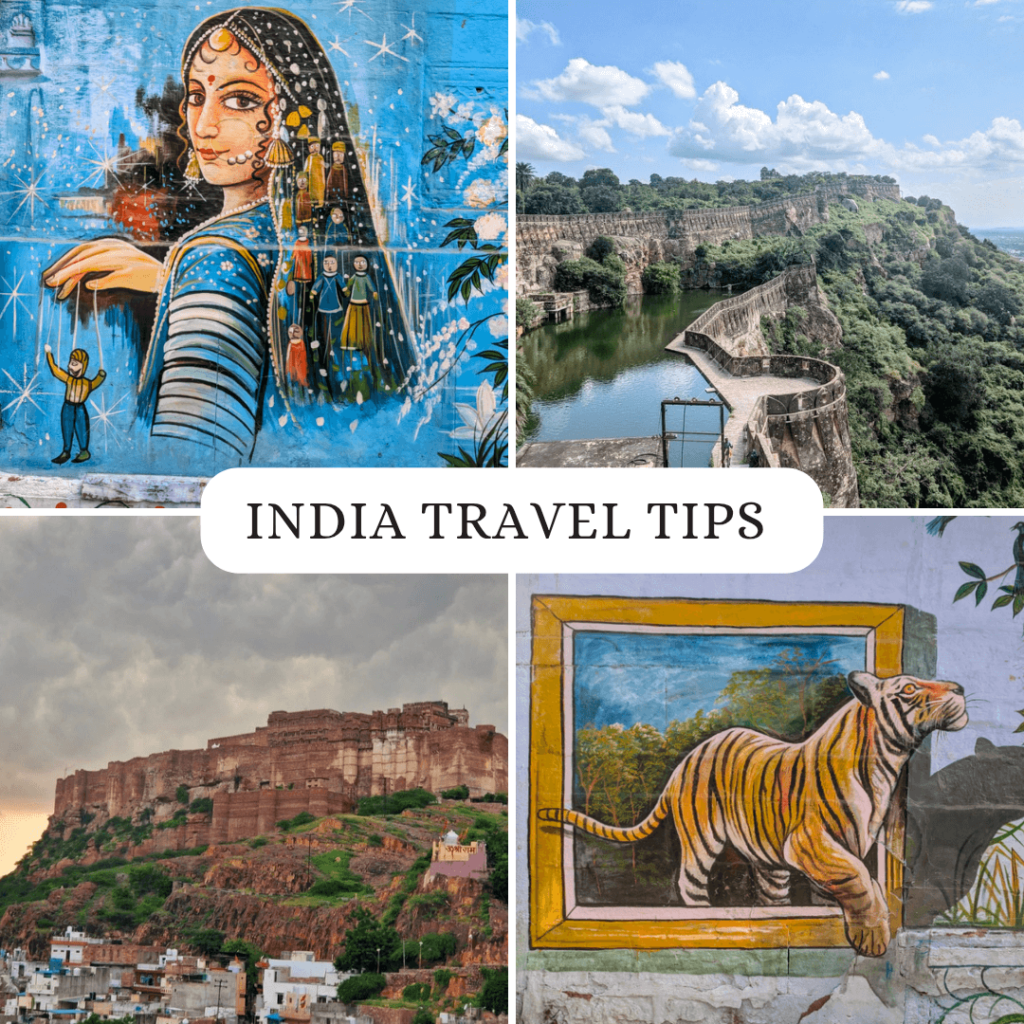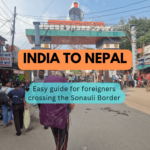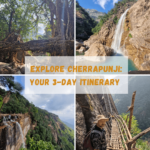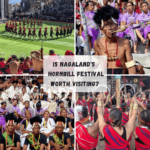Planning your first trip to India? Don’t worry! We’ve all the best India travel tips to help you feel confident and prepared for your adventure.
Despite the horror stories you may come across online, India is not as daunting as it seems. In this India travel guide, we’ll answer all your questions, such as do you need a visa for India, what are India’s hidden gems as well as the must-see attractions, when is the best time to visit, and most importantly – Is India safe to visit?
India is a country that leaves a lasting impression, and after spending six months there across two visits, we can’t wait to return. From vibrant cities to tranquil hill stations, every moment we spent exploring India was unforgettable.
Let’s waste no time in offering you all our best India travel tips so you can get planning your own unforgettable India itinerary.
What You Need to Know for Your First Trip to India
Planning your first trip to India can be both exciting and overwhelming. To help you prepare for the adventure ahead, we’ve put together everything you need to know to make your Indian adventure smooth and memorable.
First up, an important one, is your India visa!
1 – Do You Need an Indian Visa?
The first travel tip we’ll share for your trip to India is about the Indian visa. You will need a visa to enter India, and the easiest option is to apply for an e-Tourist visa before you arrive in India.
E-Visa for India – India offers a range of e-visa options based on the duration of your stay, from 30-day visas to multi-year permits lasting up to 5 years. Approval typically takes just 3-4 business days. E-visa fees generally range from $10 to $80, depending on the length of your visit. Once approved, you can proceed directly to the immigration desk for your stamp.
| 30-day e-Tourist Visa (during July to March) | US $ 25.00 |
| 30-day e-Tourist Visa (April to June) | US $ 10.00 |
| One year e-Tourist Visa | US $ 40.00 |
| Five-year e-Tourist Visa | US $ 80.00 |
We chose a 1-year multi-entry visa since we planned to include a visit to Nepal in our India itinerary. You can read about our journey from India to Nepal through the Sonauli border. We traveled back to India from Nepal via the Raxaul Border 5 weeks later – if this is something you are considering then the 1-year multi-entry visa may be the best option.
Read about our experience with the one year multiple-entry visa for India at the land border crossings between Nepal and India.
Travel tip – Make sure your passport has at least six months of validity and enough blank pages for stamps and always apply for your visa through the official Indian government website to avoid hefty third-party fees or delays.
*All official government websites for visa applications always end with “.gov”.
2 – India Weather: What is the Best Time to Visit India?
In our next India travel tip, we’ll cover the best times to visit.
The summer months, from April to June, can get very hot, especially in cities like Delhi and Jaipur, with temperatures soaring above 40°C (104°F).
On the other hand, India’s winter months (November to February) offer much more pleasant weather, with daytime temperatures ranging from 10°C (50°F) to 25°C (77°F), making it the most popular time to visit.
Just be prepared for chilly evenings, particularly in northern and hill station areas in the East, as most accommodations may not have central heating.
We visited India from September to November, and although daytime was pleasant, we had to bundle up with blankets in the evenings during our stay in the mountains in places like Cherrapunji and Darjeeling. Remember to pack warm clothes and you’ll be fine.
The best times to visit India for the first time are during the shoulder months of October to March. During this period, temperatures are more comfortable, with pleasant days and cooler nights, making it ideal for sightseeing and outdoor activities.
3 – What are the Best Things to Do in India?
While many travelers focus on Delhi and the Taj Mahal as the main highlights on their first trip to India, there’s so much more to discover across this vibrant country.
These famous Indian destinations are part of a tourist route known as the Golden Triangle in India. This route connects three major cities: Delhi, Taj Mahal, and Jaipur. This route forms a triangle on the map, and it’s one of the most popular travel destinations in India, offering a perfect mix of rich history, culture, and stunning architecture.
Yes, The Golden Triangle offers travelers an ideal way to experience India’s most famous landmarks in a relatively short time. However, India’s diverse regions offer so much more, and we’re here to reveal all the incredible experiences beyond the well-known Indian attractions.
In Rajasthan, cities like Jasisalmer, Chittorgarh, Udaipur, and Jodhpur boast beautiful palaces, forts, and vibrant markets – Honestly, these cities are unlike anything you’ve ever seen before – they resemble ancient places straight out of a Game of Thrones movie set.
You can also explore the stunning architecture of the ancient temples in Khajuraho or take a spiritual journey in Varanasi along the Ganges River.
For adventure lovers, head to the Himalayas for trekking and wildlife experiences. In places like Rishikesh, you can try yoga by the river or white-water rafting. If you’re looking for relaxation, the beaches of Goa and Kerala in South India are perfect spots for unwinding. And let’s not forget the UNESCO-listed sites in Hampi and the caves of Ajanta and Ellora.
India is famous for its diverse landscapes, and we experienced it all by starting our India itinerary from the golden sand-dunes of Jaisalmer in the West right across to the foothills of the Himalayas in Darjeeling to the east. The options are endless, and there’s truly something for every type of traveler.
A special mention for our favorite destination in India – the enchanting state of Meghalaya, where we had the chance to experience the breathtaking beauty of the Living Root Bridges. If you can align your visit with Nagaland’s iconic Hornbill Festival, you’re in for one epic holiday in India!
Get ready for an adventure of a lifetime! Check out the affordable tour options for India and start planning your ultimate India trip today by clicking the link below.
4 – Is India Affordable to Visit?
On your first visit to India, you’ll find that it’s one of the most budget-friendly destinations in the world!
One of our top India travel tips is to dive into the local cuisine, which is both delicious and affordable. You can enjoy a meal for two at a local restaurant for as little as five to ten USD.
The cost of food in India will amaze you, and once you taste how delicious it all is, you’ll never want to leave. India can truly be as affordable as you make it – while still eating REALLY tasty food!
For those looking for a bit of luxury, India also offers a variety of high-end resorts, fine dining restaurants and premium experiences, including luxurious train journeys, all at affordable prices.
Just check out our food spending in India in the video below:
Accommodation in India offers something for everyone, from budget hostels for backpackers to luxurious 5-star resorts, and everything in between. We booked all our stays through Trip.com, paying an average of $15 per night for private double rooms with en suites. Many times, we were treated to scenic views, like those of the Taj Mahal and Jodhpur Fort. At that price, you really can’t go wrong.
One thing to watch out for when booking accommodation online is fake reviews. Some India scammers tend to post similar reviews with identical wording, often on the same date. It’s easy to spot these once you know what to look for!
As well as low-cost food and accommodation, many of India’s best attractions have low entrance fees, so you can truly can explore the country without breaking the bank.
If you’re into budget travel, other affordable destinations to consider are Thailand, Uzbekistan, and Egypt.
5 – India Scams: How to Avoid Getting Scammed on Your India Holiday
Continuing with the India scams theme, our next India travel tip for your first trip to India focuses on avoiding scams. While India is generally a welcoming destination, like many popular tourist spots, you may encounter some vendors or individuals trying to take advantage of tourists. This happens in every country, not just India.
In busy tourist destinations like Delhi, Jaipur, and Varanasi, it’s common to encounter vendors or shopkeepers attempting to charge higher-than-average prices. To avoid being overcharged, it’s important to have an idea of what things should cost and to always negotiate or politely walk away if you feel the price is too high.
India travel tip: If a salesperson refuses to offer a fair price or continues to push an unreasonable deal, simply walk away – don’t waste your time or energy.
Be cautious of other common scams, such as “friendly” strangers offering unsolicited help, free services, or security guards inviting you into restricted areas. Always stay alert, and remember that it’s okay to decline any offers that feel suspicious.
6 – India Travel Tips: What about Food Poisoning in India?
Throughout our travels in India, we were frequently asked one main question: Did we get food poisoning? The short answer – no, we didn’t.
We stuck to bottled water, but otherwise, we ate at local food stalls, enjoyed meals at local restaurants, and drank plenty of tea and coffee with zero issues (aside from a bit of weight gain!).
Indian food is sure to be a highlight of your trip – just trust your instincts (pun intended!). One of our top India travel tips is to dine where the locals do.
We’ve been traveling full-time for years without getting food poisoning, though we know it can happen anywhere.
Find out our best travel tips for eating cheap around the world.
7 – Learn the Value of Local Currency for Your First Trip To India
India uses the Indian Rupee (INR) as its currency.
An important India travel tip is to be aware of the exchange rate for Indian Rupees.
At the time of publication, 100 INR is approximately 1.10 USD, 1 EUR, 0.90 GBP, and 1.80 AUD. It’s always a good idea to check the current exchange rate before you travel to India to ensure you’re getting the best value.
8 – First Visit to India: ATMs in India
Now that you know the currency in India, let’s talk about withdrawing cash from ATMs.
ATMs are readily available throughout India, and it’s generally safe to withdraw money.
That said, always exercise caution and avoid accepting unsolicited help from strangers when withdrawing cash – it’s a simple process that doesn’t require assistance!
India Travel Tip – Two safety rules we follow are: withdrawing cash on the way back to your accommodation and only taking your ATM card when necessary, as many places in India still only accept cash so there is no need to have your ATM card with you.
9 – India Travel Tip: Learn How To Negotiate in India
An important India travel tip relates to the art of negotiation. For your first trip to India, it’s important to know that negotiating prices is a common practice in many markets and shops.
When bargaining with street vendors or shopkeepers selling everything from souvenirs to clothing and accessories, don’t accept the first price they give you. You can often lower it by at least 30%, if not more!
If you’re good at haggling, you might even bring the price down by 50% or more. For example, we once bought a pair of sunglasses for 200 INR, down from 500 INR.
In fact, once you get used to this newly acquired haggling skill, the shopping in India is so fantastic, that we recommend bringing an empty bag just for all your new purchases to take home!
That said, some vendors in India are very fair with their pricing, and you may find that the cost is already quite low, so it’s perfectly fine to pay the asking price.
10 – Prices of Main India Tourist Attractions
Most tourist attractions in India have fixed entrance fees, so there’s no need to haggle.
Expect to pay between 100 INR to 500 INR (1-5 USD) for most sights. However, there may be additional charges for specific areas within an attraction. For example, visiting the Taj Mahal has a standard entry fee of 1000 INR for foreign visitors, but additional fees apply for areas like the main mausoleum.
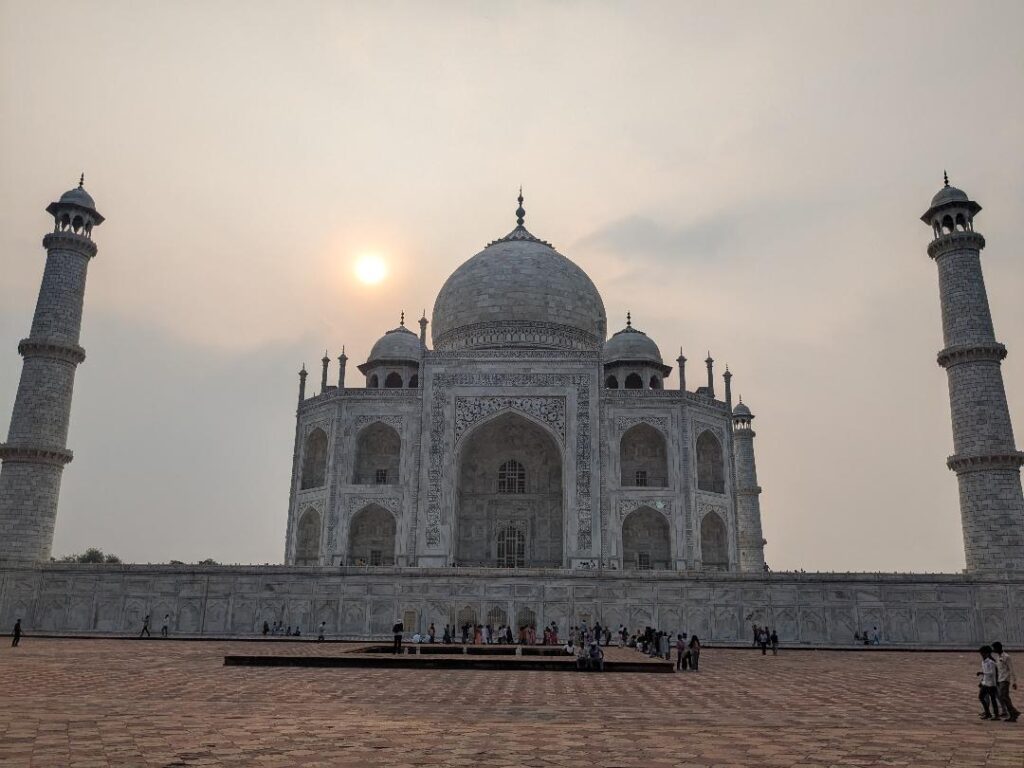
Don’t be shocked if you notice that entry fees for foreign tourists at many attractions in India are significantly higher than those for locals – sometimes as much as ten times more, like at the Taj Mahal. For detailed pricing information, be sure to check official websites of the Indian attraction in question.
The only time you may need to negotiate is for day tours. For instance, we were initially quoted 3000 INR for a day tour of Jaipur, but we managed to negotiate it down to 1000 INR total.
One of the top experiences in India is a boat tour along the Ganges in Varanasi or a multi-day trek in the Himalayas. Book your adventure today and get ready for an unforgettable first visit to India!
11 – Can You Drink Alcohol During Your First Visit to India?
Yes, you can drink alcohol in India, but there are some important India travel tips to keep in mind:
Age Restrictions: The legal drinking age varies from state to state. It can range from 18 to 25 years, depending on where you are. Always check the local laws of the state you are in.
Licensed Places: Alcohol is generally available in licensed bars, restaurants, and clubs. Some states have more relaxed laws, while others (like Gujarat, Bihar, Nagaland, and Lakshadweep) may have alcohol bans or strict regulations on its sale.
State-Specific Rules: In some states like Goa, alcohol consumption is more relaxed, and you will find a wide range of options, especially near beaches and tourist areas. However, in states with stricter laws, you may have to go to specific government-run liquor stores.
Cultural Considerations: While alcohol is consumed in many places, it’s still important to be respectful of local customs, especially in more conservative regions, such as religious or rural areas. Public drunkenness is frowned upon.
Dry Days: Some days are designated as “dry days,” meaning alcohol will not be available due to religious or national observances, such as national holidays or religious festivals. Always check for any local dry days before planning your drinks.
Enjoy responsibly, and always be mindful of local customs and regulations when drinking in India.
12 – What SIM Card to Get When Visiting India?
Don’t expect Wi-Fi to be reliable in India – often, it can be quite terrible!
A good solution is to buy a local SIM card, which is available at airports, train stations, and mobile shops in most major cities.
The main providers in India are Airtel and Vodafone. Prices range from 200 INR to 1000 INR, depending on the data plan you choose.
We went with Vodafone and paid 600 INR for a 30-day unlimited data plan.
India Travel Tip – Be sure to check that your phone is unlocked before purchasing a SIM card in India.
13 – India Travel Tip: Does India Have Good Public Transport?
Whether or not public transportation is the best option for you in India depends on your travel style.
We traveled literally from West to East of India using public transportation and had zero issues – maybe a rough night’s sleep or two but that’s to be expected! Our choice of whether to travel via train or bus depends on the most convenient times and we booked all our transport in India with 12go.
Booking with 12go offers hassle-free bookings – easy access to schedules, ticket prices, and the option to book tickets online in advance.
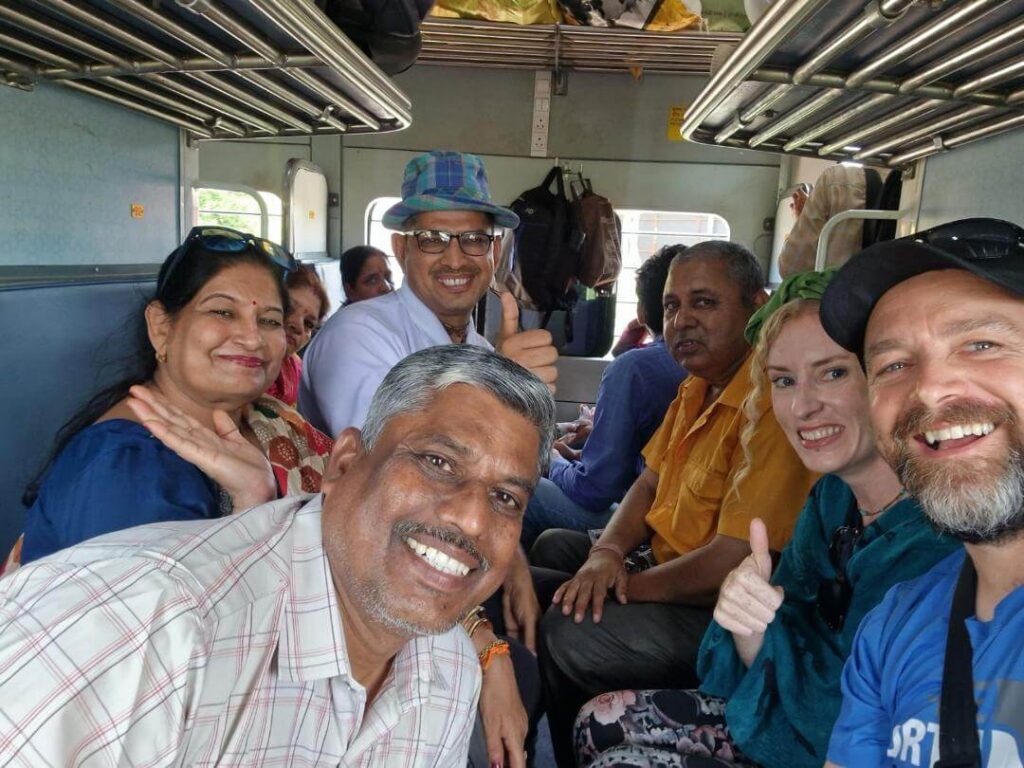
Indian trains, in particular, offer a variety of classes, from basic sleeper options to more comfortable air-conditioned coaches, so you can choose according to your budget and comfort preferences.
Take a look at our experience across the different train classes. We’re sure that India’s train travel has something to suit every type of traveler. While you’re at it have a look at our India travel playlist so you can know exactly what to expect from your first visit to India.
If you’re backpacking or looking to save on costs, it’s a great idea to stay near key transportation hubs, such as bus stations or metro lines, to easily navigate the cities without relying on taxis or ride-hailing services like Uber.
Major cities like Delhi, and Mumbai have extensive metro networks that are both affordable and convenient. For example, a metro ride in Delhi costs as little as 10 INR (roughly 12 cents USD), depending on the distance traveled, making it one of the most budget-friendly ways to get around during your India holiday.
Public buses, local trains, and even auto-rickshaws are also available at low prices, though they may (they will!) be more crowded, especially during peak hours.
For long-distance travel within India, especially between major cities or remote areas, it’s worth considering a flight. Sometimes, the benefits far outweigh the drawbacks. For just a little extra cost, you can avoid hours of mental strain and save a day or two of travel time – it’s all about picking your battles. For example, at the end of our India itinerary, we flew from Guwahati to Kolkata. For just an extra $20, we saved ourselves over 48 hours of bus travel!
Be aware that booking at bus stations can sometimes be a challenge due to language barriers, so having Google Translate handy might save you time.
For hassle-free travel planning, purchase your ticket online on 12GO.
So, is India affordable for travel? Absolutely! With a bit of planning, public transport offers a cost-effective, immersive and let’s face it, fun, way to explore the country!
13.1 – India Travel Tip: Uber is Available
Taxis are readily available in India, but if you want to avoid haggling and ensure a fair fare, we recommend using ride-hailing apps like Uber or Ola, which are widely available in most major cities.
These apps offer transparent pricing, so you won’t have to worry about being overcharged, and you can avoid the typical negotiation process.
If you do choose to take a traditional taxi, it’s important to agree on the fare before starting your journey, as let’s face it, more than likely you will be over-charged, ESPECIALLY in busy tourist areas. Using a ride-hailing app can save you time and money, giving you a more relaxed and stress-free travel experience in India.
Our favorite way to get around cities in India, however, is to simply wander. Put on some decent footwear, clock up the miles, and enjoy the local life!
14 – What Socket Type to Use During Your India Holiday?
Before your first trip to India, keep in mind that the country uses the plug type C, which are different from the ones used in countries like the US, UK, and Australia.
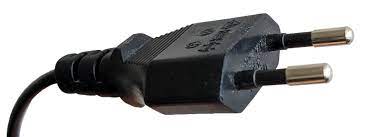
If you’re traveling from these regions, be sure to bring the appropriate power adapter or converter to charge your electronic devices.
What packing essentials do I need for my India trip?
All of the products mentioned have been owned and are used by us. Or else we have purchased these travel accessories for family and friends. Most importantly, these travel accessories are practical, durable, affordable, and perfect for all types of traveler.
- Multi Travel Adapter – A Type C plug is used in Egypt, but with a universal travel adapter, you’ll be equipped to handle any plug type in the world.
- Dry-Bag – Protect your belongings for those beach/salt lake adventure days.
- Bum Bag – Protect all your belongings such as money and ATM cards.
- Battery Pack – this travel gadget lets you recharge your electronic devices such as phones, tablets, or cameras.
- A packable lightweight jacket – Visiting Egypt in January – March can get quite cold.
- Shemagh – A traditional Middle Eastern scarf also known as a keffiyeh, that offers protection from the sun.
- Booney Hat – Don’t forget a booney hat to protect from the sun.
15 – What Language is Spoken in India?
In case you haven’t yet realised, India is huge!! and there are many languages spoken across the country.
The official languages are Hindi and English, with Hindi being widely spoken in northern India. However, India has over 20 recognized languages, including regional languages like Bengali, Tamil, Telugu, Marathi, Gujarati, and Punjabi, to name a few.
Although English is commonly used, for your first visit to India, learning a few basic phrases in Hindi can be helpful, and it is nice to make an effort after all.
Trust us Indian people will be grateful for your attempts to learn Hindi.
We are here to help you out with our top 10 Hindi phrases to learn:
Namaste (नमस्ते) – “Hello” or “Greetings”
Shukriya / Dhanyavaad (शुक्रिया / धन्यवाद) – “Thank you”
Kripya (कृपया) – “Please”
Haan (हाँ) – “Yes”
Nahi (नहीं) – “No”
Bohot swadisht (बहुत स्वादिष्ट) – “Very delicious” *You’ll be using this one A LOT!
Mujhe madad chahiye (मुझे मदद चाहिए) – “I need help”
Kitna hai? (कितना है?) – “How much is this?”
Mujhe samajh nahi aata (मुझे समझ नहीं आता) – “I don’t understand”
Sahi (सही) – “Correct” or “Right”
Knowing these simple Indian phrases can go a long way in making your first trip to India a whole lot easier and can deepen your interaction with locals. Remember it’s nice to be nice!
16 – India Travel Tip: Respect Religion & Culture
In India, Hinduism is the predominant religion, with around 80% of the population identifying as Hindu. However, India is a diverse country with a rich mix of religions, including Islam, Christianity, Sikhism, and others.
While India is generally welcoming to tourists, it’s important to respect local traditions, customs, and laws during your visit
16.1 – What should I wear during my India Holiday?
Tourists are not expected to dress formally in India, but there are a few cultural considerations to keep in mind.
In certain places, such as at certain religious sites, women may choose to wear scarves or head coverings, though it’s not a strict requirement.
Women are encouraged to dress modestly by covering their shoulders and avoiding overly revealing clothing, such as shorts, short skirts, and crop tops, particularly when visiting temples, religious sites, and rural areas. In cities like Mumbai and Delhi, you will see a wide range of fashion, but it’s always a good idea to respect local norms.
Kate from Happy Irish Wanderers typically wore a t-shirt and pants while traveling through India, always keeping a scarf handy for visits to places of worship. If you don’t have a scarf, not to worry, Kate picked up three while visiting India for 60 INR per scarf – now that’s a great deal!
However, when you’re relaxing at a beach resort or in more tourist areas of India, the dress code is generally more relaxed, and casual attire is perfectly fine!
17 – Is India Safe to Visit?
The big question many people ask is, “Is it safe to visit India?” And the answer is, yes, it is absolutely safe!
During our trip to India, we met some of the friendliest, most helpful, and honest people. We had several instances where locals went out of their way to return lost items or guide us in the right direction. We never felt unsafe, even when walking the streets late at night.
While it’s true that every country has its share of scams or petty crime, it’s unfair to judge an entire nation based on those isolated incidents – this can happen anywhere in the world.
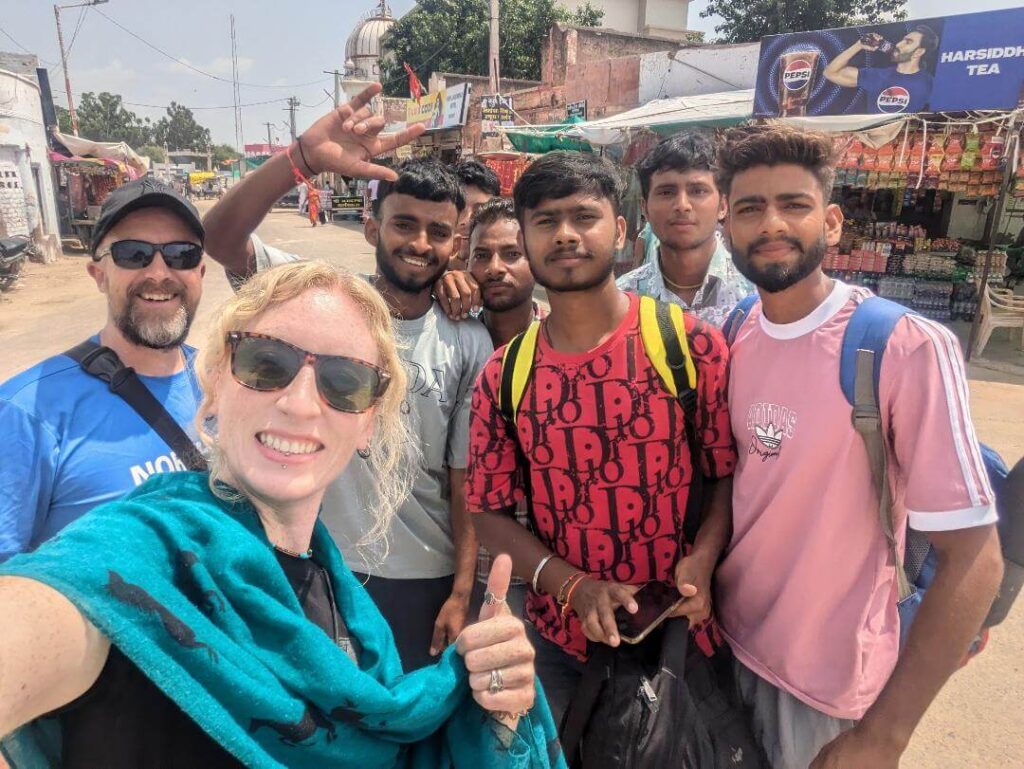
99% of the time Indian people will just want a selfie with you!
India Travel Tip – Always use common sense and trust your instincts.
Now that you’re prepared for your first trip to India, all that’s left is to book your flight!
17.1 – Is India Safe for Women?
India is safe for women, but like in any country, there are certain precautions you should take to ensure your safety when traveling as a female.
Most tourists, including women, visit India without any issues, but it’s important to be aware of your surroundings, especially in crowded areas or unfamiliar places.
Here are a few tips to stay safe in India as a female:
Dress modestly – India is diverse, and dress codes can vary by region. In general, it’s recommended to wear conservative clothing to respect local customs.
Avoid isolated areas – Especially after dark, it’s best to stick to well-lit and populated areas.
Use reliable transportation – Opt for trusted taxis or rideshare apps like Uber, and avoid traveling alone late at night.
Trust your instincts – If a situation doesn’t feel right, remove yourself from it. You can always ask for help from trusted locals, hotel staff, or authorities.
Stay connected – Share your India travel itinerary and keep in touch with family or friends regularly.
While most women travel safely in India and have a wonderful experience, staying aware and cautious is key to enjoying a safe India trip.
18. Is India Worth Visiting?
Overall, would we recommend a trip to India? Absolutely! India is 100% worth visiting.
India is an amazing country with some of the most iconic attractions in the world, incredible people, and very affordable prices.
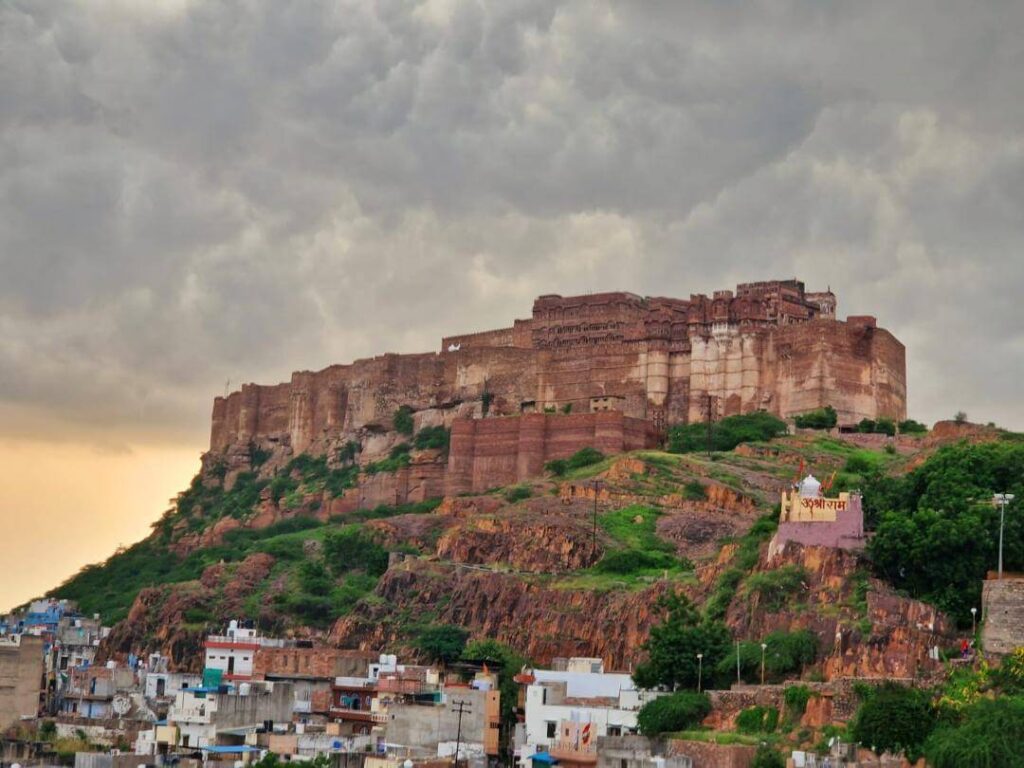
We absolutely LOVE our time in India each time we visit, and the only downside is that we wish we had more time to explore everything this diverse country has to offer!
India is now one of our favorite countries and once we leave we are counting down the days until our next India travel.
Enjoy Your India Holiday!
How did you find these India travel tips? Did we cover all your questions, or are there still some lingering ones to help you prepare for your first visit to India?
If so please get in touch, we are always more than happy to help.
We would love to hear your thoughts about our India travel tips and how you got on visiting India. Please feel free to leave us a message below or contact us through our socials.
Slán go fóil


This post contains affiliate links. If you click on the links to make a purchase, we will earn a small commission. This is at NO EXTRA COST to you. This is a free way to support us and allow us to continue to create inspiring adventure travel guides.

